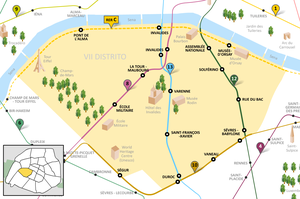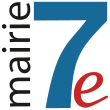7th arrondissement of Paris
7th arrondissement of Paris | |
|---|---|
 View of the Eiffel Tower and Les Invalides, two landmarks of the 7th arrondissement | |
 Location within Paris | |
| Coordinates: 48°51′33″N 2°18′46″E / 48.85917°N 2.31278°E | |
| Country | France |
| Region | Île-de-France |
| Department | Paris |
| Commune | Paris |
| Government | |
| • Mayor (2020–2026) | Rachida Dati (SE) |
Area | 4.09 km2 (1.58 sq mi) |
| Population (2022)[1] | 48,196 |
| • Density | 11,784/km2 (30,520/sq mi) |
| INSEE code | 75107 |
 20 arrondissements of Paris | |||||||||||||||||||||||||||||||||||||
|---|---|---|---|---|---|---|---|---|---|---|---|---|---|---|---|---|---|---|---|---|---|---|---|---|---|---|---|---|---|---|---|---|---|---|---|---|---|
|
|||||||||||||||||||||||||||||||||||||
The 7th arrondissement of Paris (VIIe arrondissement) is one of the 20 arrondissements of the capital city of France. It is known for being, along with the 16th arrondissement and the commune of Neuilly-sur-Seine, the richest neighbourhood in France. In spoken French, this arrondissement is referred to as le septième.
The arrondissement, called Palais-Bourbon in a reference to the seat of the National Assembly, includes some of the major and well-known tourist attractions of Paris, such as the Eiffel Tower, the Hôtel des Invalides (Napoleon's resting place), the Chapel of Our Lady of the Miraculous Medal,[2] as well as a concentration of museums such as the Musée d'Orsay, Musée Rodin and the Musée du Quai Branly – Jacques Chirac.
Situated on the Rive Gauche—the "Left" bank of the River Seine—this central arrondissement, which includes the historical aristocratic neighbourhood of Faubourg Saint-Germain, contains a number of French national institutions, among them the National Assembly and numerous government ministries. It is also home to many foreign diplomatic embassies, some of them occupying outstanding hôtels particuliers.
The arrondissement has been home to the French upper class since the 17th century, when it became the new residence of France's highest nobility. The district has been so fashionable within the French aristocracy that the phrase le Faubourg—referring to the ancient name of the current 7th arrondissement—has been used to describe French nobility ever since.[3] The 7th arrondissement of Paris and Neuilly-sur-Seine form the most affluent and prestigious residential area in France.[4]
History
[edit]

During the 17th century, French high nobility started to move from the central Marais, the then-aristocratic district of Paris where nobles used to build their urban mansions[5] (see Hotel de Soubise), to the clearer, less populated and less polluted Faubourg Saint-Germain.
The district became so fashionable within the French aristocracy that the phrase le Faubourg has been used to describe French nobility ever since.[3] The oldest and most prestigious families of the French nobility built outstanding residences in the area, such as the Hôtel Matignon, the Hôtel de Salm, and the Hôtel Biron.
After the Revolution many of these mansions, offering magnificent inner spaces, many reception rooms and exquisite decoration, were confiscated and turned into national institutions. The French expression "les ors de la Republique" (literally "the golds of the Republic"), refers to the luxurious environment of the national palaces (outstanding official residences and priceless works of art), comes from that time.
During the Restauration, the Faubourg recovered its past glory as the most exclusive high nobility district of Paris and was the political heart of the country, home to the Ultra Party. After the Fall of Charles X, the district lost most of its political influence but remained the centre of the French upper class' social life.
During the 19th century, the arrondissement hosted no fewer than five Universal Exhibitions (1855, 1867, 1878, 1889, 1900) that have immensely impacted its cityscape. The Eiffel Tower and the Orsay building were built for these Exhibitions (respectively in 1889 and 1900).
Geography
[edit]The arrondissement has a total land area of 4.088 km2 (1.578 sq mi; 1,010 acres).
Demography
[edit]The 7th arrondissement attained its peak population in 1926 when it had 110,684 inhabitants. Because it is the location of so many French government bodies, this arrondissement has never been as densely populated as some of the others.[citation needed] In 1999, the population was 56,985, while the arrondissement provided 76,212 jobs.
Historical population
[edit]| Year (of French censuses) |
Population | Density (inh. pr km2) |
|---|---|---|
| 1872 | 78,553 | 19,206 |
| 1926 (peak year) | 110,684 | 27,075 |
| 1954 | 104,412 | 25,529 |
| 1962 | 99,584 | 24,360 |
| 1968 | 87,811 | 21,480 |
| 1975 | 74,250 | 18,163 |
| 1982 | 67,461 | 16,502 |
| 1990 | 62,939 | 15,396 |
| 1999 | 56,985 | 13,940 |
| 2009 | 57,442 | 14,045 |
Immigration
[edit]| Born in metropolitan France | Born outside metropolitan France | |||
|---|---|---|---|---|
| 78.3% | 21.7% | |||
| Born in overseas France |
Born in foreign countries with French citizenship at birth1 | EU-15 immigrants2 | Non-EU-15 immigrants | |
| 0.5% | 4.9% | 7.4% | 8.9% | |
| 1 This group is made up largely of former French settlers, such as pieds-noirs in Northwest Africa, followed by former colonial citizens who had French citizenship at birth (such as was often the case for the native elite in French colonies), as well as to a lesser extent foreign-born children of French expatriates. A foreign country is understood as a country not part of France in 1999, so a person born for example in 1950 in Algeria, when Algeria was an integral part of France, is nonetheless listed as a person born in a foreign country in French statistics. 2 An immigrant is a person born in a foreign country not having French citizenship at birth. An immigrant may have acquired French citizenship since moving to France, but is still considered an immigrant in French statistics. On the other hand, persons born in France with foreign citizenship (the children of immigrants) are not listed as immigrants. | ||||
Notable residents
[edit]Cityscape
[edit]-
Champ-de-Mars view from the top of the Eiffel Tower
-
The Eiffel Tower
-
St. Louis Chapel of the Hôtel des Invalides view from avenue de Breteuil
-
Inside Hôtel des Invalides's Chapel
-
View of rue de Solférino from the Léopold-Sédar-Senghor bridge
-
The Seine and the 7th arrondissement as seen from the Eiffel Tower
-
Typical Parisian architecture in the 7th arrondissement
Places of interest
[edit]
Important places include:
- Palais Bourbon, meeting place of the National Assembly
- Eiffel Tower
- Cathedral of Saint-Louis-des-Invalides, Paris
- Hôtel Matignon
- Hôtel de Boisgelin (Rue de Varenne, Paris), historic building, home to the Italian embassy in Paris.
- Hôtel de Besenval
- Champ de Mars
- Musée d'Orsay
- École Militaire
- Hôtel des Invalides
- Maison Gainsbourg
- Maison de Verre
- Musée du quai Branly
- Musée national de la Légion d'Honneur et des Ordres de Chevalerie
- Musée Maillol
- Musée de l'Ordre de la Libération
- Musée Rodin
- Musée Valentin Haüy
- Institut d'Études Politiques de Paris (Sciences Po)
- Cathedral of Saint-Louis-des-Invalides, Paris
- Saint-Pierre-du-Gros-Caillou
Art and industry
[edit]- Musée du quai Branly
- Musée national de la Légion d'Honneur et des Ordres de Chevalerie
- Musée Maillol
- Musée de l'Ordre de la Libération
- Musée Rodin
- Musée Valentin Haüy
- National Horticultural Society of France
Economy
[edit]Air Liquide,[6] Alcatel-Lucent,[7] and Valode & Pistre have their head offices in this arrondissement.[8]
Education
[edit]This section needs expansion. You can help by adding to it. (October 2015) |
Public and private high schools:
- Lycée Victor-Duruy
- Établissement La Rochefoucauld
- Institut de l'Alma
- Lycée-collège Paul-Claudel
- Lycée d'Hulst
- Lycée Sainte-Jeanne Elisabeth
- Lycée Saint-Thomas-d'Aquin
- Lycée Thérèse-Chappuis
Istituto Statale Italiano Leonardo Da Vinci, an Italian international school, maintains two campuses in the arrondissement.[9] The American University of Paris, a private liberal arts university, maintains several buildings near the Quai d'Orsay.[10]
Government
[edit]The Ministry of Agriculture, the Ministry of Foreign Affairs and the Ministry of National Education have their head offices in the arrondissement.
Politically, the arrondissement is situated firmly on the right. The mayor of the 7th, Rachida Dati, was Minister of Justice under Nicolas Sarkozy's presidency and a member of the European Parliament for the centre-right UMP from 2009 to 2019. [11][12]
In the 2017 French presidential election, the 7th gave right-wing candidate François Fillon 52.7% of its votes in the first round, compared to his poor national showing of only 20%. It then went on to vote for Emmanuel Macron in the runoff by a landslide.
| Election | Winning candidate | Party | % | |
|---|---|---|---|---|
| 2017 | Emmanuel Macron | EM | 88.07 | |
| 2012 | Nicolas Sarkozy | UMP | 71.76 | |
| 2007 | Nicolas Sarkozy | UMP | 74.75 | |
| 2002 | Jacques Chirac | RPR | 89.17 | |
| 1981 | Valéry Giscard d'Estaing | UDF | 71.44 | |
Sport
[edit]The arrondissement hosted the equestrian events for the 1900 Summer Olympics.[13]
References
[edit]- ^ "Populations de référence 2022" (in French). The National Institute of Statistics and Economic Studies. 19 December 2024.
- ^ "Chapel of our Lady of the Miraculous Medal". Paris Digest. 2018. Retrieved 21 November 2018.
- ^ a b Balzac explains the very specific Faubourg's aristocratic way of life in his novel La Duchesse de Langeais
- ^ Drouin, Olivier (22 August 2013). "Les 80 communes où se concentrent les plus hauts revenus". Capital.fr (in French). Archived from the original on 6 June 2017. Retrieved 19 April 2016.
- ^ Hotels particuliers
- ^ "Legal notice." Air Liquide. Retrieved on 7 July 2010.
- ^ "Alcatel-Lucent Fact Sheet Archived 2010-08-29 at the Wayback Machine Retrieved on 17 August 2011 "Headquarters 3 av. Octave Gréard 75007 Paris, France"
- ^ Valode & Pistre Archived 2011-07-17 at the Wayback Machine (in English) - Select "Contact". Valode & Pistre. Retrieved on 2 July 2010. "115 rue du Bac 75007 PARIS - FRANCE
- ^ "L'OFFERTA FORMATIVA ITALIANA NELLA CIRCOSCRIZIONE CONSOLARE DI PARIGI Archived 24 May 2016 at the Wayback Machine." Italian Consulate in Paris. Retrieved on 19 October 2015. "Amministrazione, Scuola Media e Liceo Scientifico 12 rue Sédillot - 75007 Parigi" and "Scuola Elementare 3 bis Avenue de Villars - 75007 Parigi" - See map
- ^ "University History | The American University of Paris". aup.edu. Archived from the original on 4 March 2016. Retrieved 29 June 2016.
- ^ " Mentions légales." Ministry of Agriculture. 8 June 2007. Retrieved on 6 May 2011. "Ministère de l’Agriculture, de l’Alimentation, de la Pêche, de la Ruralité et de l’Aménagement du territoire 78, rue de Varenne - 75349 Paris 07 SP"
- ^ "à propos du site - mentions légales - crédits." Ministry of National Education. Retrieved on 6 May 2011. "Ministère de l’éducation nationale, de la jeunesse et de la vie associative Secrétariat général - Délégation à la communication 110 rue de Grenelle 75007 Paris"
- ^ 1900 Summer Olympics official report Archived 28 May 2008 at the Wayback Machine. p. 16. Accessed 14 November 2010. (in French)
External links
[edit] 7th arrondissement travel guide from Wikivoyage
7th arrondissement travel guide from Wikivoyage
Lua error in Module:Navbox at line 192: attempt to concatenate field 'argHash' (a nil value).










